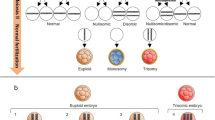Abstract
Purpose: Our purpose was to summarize our experience gained using fluorescence in situ hybridization for preimplantation diagnosis at the Rambam Medical Center.
Methods: Seventy-three embryos (29 cycles) were analyzed for preimplantation diagnosis for the following indications: advanced maternal age (>39 years), X-linked diseases, poor-quality embryos, repeated failure in vitro fertilization cycles and fast-dividing embryos. An additional 38 embryos with unequal pronuclei size were examined for ploidy. Biopsy of embryonic blastomeres was performed at the six- to eight-cell stage. Five fluorescence probes, for chromosomes X, Y, 13, 18, and 21, were applied for ploidy detection.
Results: Eighty-four (87%) blastomeres of the 73 embryos analyzed showed clear signals. Six of the blastomeres were lost during spreading. Two of the embryos were destroyed following biopsy. No nucleus was found in five of the blastomeres, while in nine, more than one nucleus was verified. Transfer was performed in 10 patients (32 embryos). Two pregnancies were achieved. Two healthy babies were born. Fifty-seven percent of the fast-dividing embryos demonstrated normal signals. In two groups of embryos of unequal pronuclei size, following conventional insemination and intracytoplasmic sperm injection, 50 and 11.4% demonstrated normal signals.
Conclusions: The efficiency of florescence in situ hybridization for aneuploidy detection is 87 and 97% for autosomes and gonosomes, respectively. The preimplantation genetic diagnosis is suitable for selected in vitro fertilization cases including fast-dividing embryos and embryos with unequal pronuclei size following regular in vitro fertilization.
Similar content being viewed by others
REFERENCES
Handyside AH, Kontogianni EH, Hardy K, Winston RML: Pregnancies from biopsied human preimplantation embryos sexed by Y specific DNA amplification. Nature 1990;244:768-770
Tarin JJ, Handyside AH: Embryo biopsy strategies for preimplantation diagnosis. Fertil Steril 1993;59:943-956
Munné S, Lee A, Rosenwaks Z, et al. Diagnosis of major chromosome aneuploidies in human preimplantation embryos. Hum Reprod 1993;8:2185-2191
Antonarakis SF: Chromosome mapping using DNA probes: A case study (chromosome 11) and future possibilities. In VA McKusick, TH Roderick, J Mori, NW Paul (eds). Medical and Experimental Mammalian Genetics: A Perspective. New York, Alan R. Liss, 1987
Griffin DK, Handyside AH, Harper JC, et al.: Clinical experience with preimplantation diagnosis of sex by dual fluorescent in situ hybridization. J Assist Reprod Genet 1994;11:132-143
Munné S, Alikani M, Tomkin G, et al.: Embryo morphology, developmental rates, and maternal age are correlated with chromsome abnormalities. Fertil Steril 1995;64:382-391
Manor D, Kol S, Lewit N, Lightman A, Stein D, Pillar M, Itskovitz-Eldor J: Undocumented embryos: Do not trash them, FISH them. Hum Reprod 1996;11:2502-2506
Author information
Authors and Affiliations
Rights and permissions
About this article
Cite this article
Manor, D., Stein, D. & Itskovitz-Eldor, J. Preimplantation Diagnosis by FISH: The Rambam Experience. J Assist Reprod Genet 15, 308–309 (1998). https://doi.org/10.1023/A:1022500728945
Issue Date:
DOI: https://doi.org/10.1023/A:1022500728945




